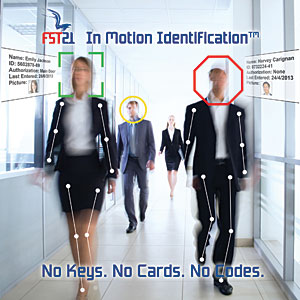
|
Getting older is just a weird experience. Although my body says differently, my mind still thinks I am 18 years old.
My recent visit to the ASIS show in Chicago demonstrated that my “18-year-old” brain just does not work the way it did when I was younger. Walking through the show, I saw a number of people that I’ve known in our industry for many years, but in many cases I could not remember their names. When faced with this social problem my technique is simple: “Glad to see you’re still (alive/in the business/upright)” or some such salutation along with a hearty handshake.
One person that I remembered was my friend Mark Ingram, who is the director of U.S. sales for FST21, an identity management and access control company. After a brief demonstration of the company’s In Motion Identification™ system, I quickly realized that while I might sometimes remember a face, the analytic software from FST21 always remembers faces and makes a person’s face and walking body movements become their access control key.
Available in a number of configurations, all of the FST21 In Motion Identification systems operate in a similar fashion. Authorized users are enrolled by taking multiple head-on pictures with a minimum 5-megapixel IP surveillance camera or by digital snapshot. The software will select the best pictures and store the facial information in the database. Each access-controlled opening (door or gate) is equipped with a 5-megapixel IP camera mounted to provide head-on views of people approaching the door. When the system recognizes the user, the system administrator can set up a number of options. Some persons will be allowed immediate access, with a green-lit indication that they are good to enter. Other people may trigger a text message to a smart device, where a building administrator then can view the person live and decide whether or not to allow their entry, which can be activated by their smart device. As authorized persons continue to use the system, the software will start to memorize their body movements and walking gaits so that the first time a person comes to the door, the system might take two seconds to recognize their face. After a few entries, the system’s response time is slashed to milliseconds upon viewing the authorized person.
While this technology initially may appear to be best suited for high-security applications, the people at FTS21 have packaged their technology into a simple kit called the Digital Doorman™, which includes everything needed to install and manage a single door entryway using In Motion Identification technology.
This package includes a mini-server, software, a 5-megapixel high-quality IP camera for mounting by the door, a VoIP IP intercom with QR code reader, a digital snapshot camera for taking enrollment facial photos, the green-light feedback sign, and a light meter to make sure that the entryway has a minimum of 300 lux for proper camera viewing.
What I think is cool about this product — besides the In Motion Identification, which means there are no cards to lose or issue — is that the intercom provides a keypad for connecting to users inside the building. If a visitor walks up to the door, he or she can view a directory (not included with the package) and press a simple code that is programmed to dial an authorized person’s smartphone. The phone will initiate a conversation with the visitor, and the host can allow entry. Alternatively, an authorized user can send a QR code to their visitor, which they can display on their smartphone and it will be read by the IP intercom/system interface. This system can readily replace an older telephone-based building access panel, which is becoming a major issue as many end users are dumping their traditional POTS telephone lines and just packing their smartphones.
Now your customer’s face becomes their access control key, and it is something they will never lose. The Digital Doorman™ product was a winner of the ASIS Accolades award at the Chicago show and is well worth your checking out. For information, visit www.FST21.com.
David Engebretson is the president of Slayton Solutions Ltd., Chicago, providing online and instructor-led training on fiber optics and networking electronic security systems. His latest book, Technician’s Guide to Physical Security Networking: Enterprise Solutions is a fully illustrated manual describing high-end IP physical security applications. Visit www.slaytonsolutionsltd.com for ordering information.






